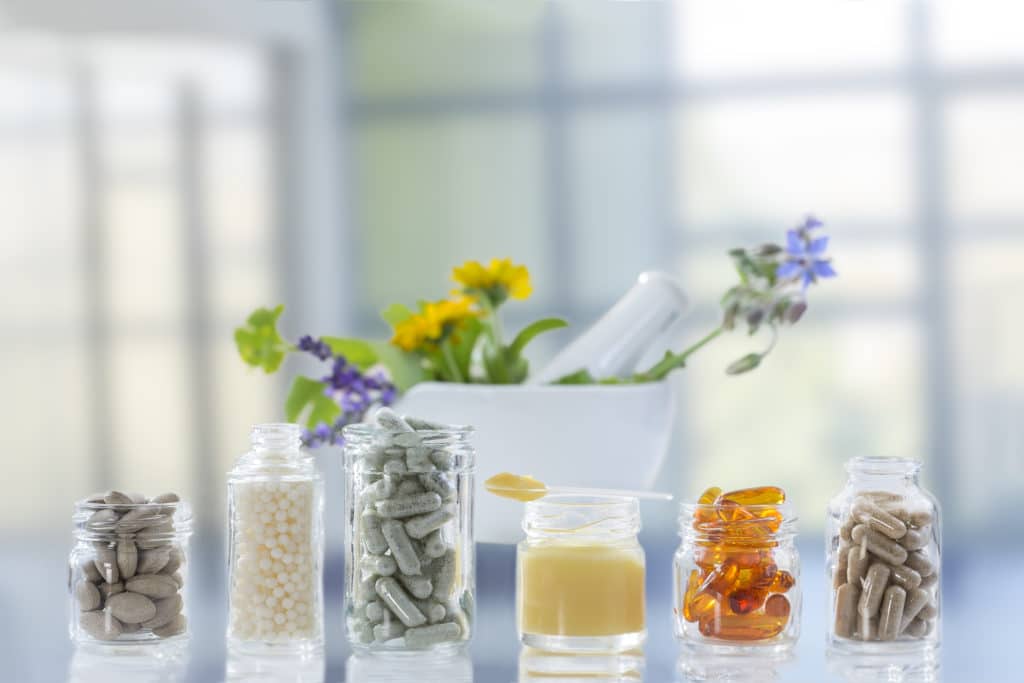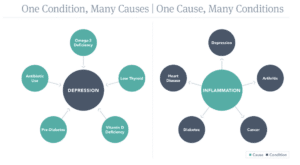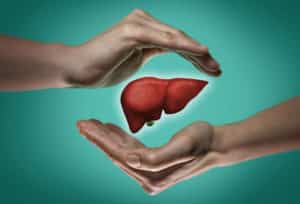I remember going back to work after baby #2.
I was a wreck.
I snot cried for a week.
I was angry not to have more time.
I did not know how I would be up with this wee one all night (my husband worked nights) and then function at work all day. I had anxiety about being separated so suddenly for five long days in a row. I’d just worked part time with my first, so this was new for me.
Upon going back to work, I noticed that I started having a lot of brain fog; I’d be doing one thing and then chase the next thing that showed up to do, forgetting what I’d been doing before. I had trouble staying on task. At night I’d feel exhausted and fall asleep, but after waking to feed the baby, I’d lay there unable to fall back to sleep. When my alarm went off, I’d feel like a zombie.
I was already eating foods to support myself, meditating daily, and doing the best I could to find time for myself, SO it was time to see what supplements would be supportive. I added in a couple and adjusted what I was already taking. I got the results I was hoping for. Within a week I felt more focused at work and was drifting back into sleep more easily at night.
Upon going back to work after maternity leave, I’d had a sudden shift in hormones; less oxytocin. Lower serotonin. Higher levels of cortisol. And I really felt these changes. By this point I’d done enough functional medicine work to know the systems in my body pretty well. I was able to identify what supplements would be most supportive. Upon adding them in, I felt like I could make the transition.
There are a multitude of supplements that can help balance hormones. Some are appropriate once we see a hormone panel and get a good picture of what’s happening in the body. Others are appropriate for hormone balance in general. These are the ones I’ll touch on in this article to give you a nice foundation from which to start. We’ll also touch on some lifestyle approaches that are vital for healthy hormones.
The Calming Mineral
Magnesium is often referred to as ‘the calming mineral’ because it can have that effect on the mind and body. It is what helps your muscle cells relax and is involved in over 300 biochemical reactions in the body. It helps to calm the nervous system and prevent the production of excess cortisol. It is involved in blood sugar metabolism. Low levels of magnesium have been shown to increase insulin resistance, commonly found with PCOS, estrogen dominance, and other hormone imbalance issues. Some of the symptoms of magnesium deficiency can manifest as irritability, restlessness, a lack of concentration, and fatigue.
Magnesium deficiency is also increasing due to a decline of magnesium in our food sources over the years. There are reports that estimate that magnesium content in vegetables has seen declines up to 80% since the pre-1950 figures! This important mineral is one that even those on a very healthy diet may need to supplement with in order to get optimal amounts. There are many different forms, and they have various purposes. I tend to recommend magnesium glycinate. When magnesium is chelated to glycine, it not only absorbs well, but glycine is also a calming amino acid and we don’t tend to get enough glycine in the diet anyway. It can help with sleep so feel free to take it before bed. Another option is to take it in the morning or in divided doses throughout the day.
Vitamin D

The best way to know if you need this is to get a blood test to see what your levels are. The functional range is 40-60 ng/ml, so if you’re below this, you definitely want to supplement. There are cases where having it a bit higher than this may be helpful, but in general this is the ideal range to be in. You can get too much Vitamin D, so if you don’t know your levels, you’ll want to start with a lower dose, which is typically 1,000-2,000 IU per day. It can certainly be taken in much higher doses if you discover that your levels are low.
My clients often say, “Well, don’t I get this from the sun?” YES! You do get this from the sun, and to do so, you need to be outside between 10am-3pm during the summer months (in much of the US) with as much skin exposed as possible without sunscreen for half of the amount of time it would take you to burn. Then not use soap on your skin for 24-48 hours afterwards so that the oils in your skin can work to synthesize that vitamin D. Oh, and you need to do this five days per week. Every once in a while, I have a client who says this is do-able, but most people don’t get this much sunshine in today’s modern world. If you think this vitamin would be helpful for you to supplement, make sure to get D3 (not D2). This is the active form and will be better utilized by your body.
B Complex
B vitamins are vital for hormone balance. They are very involved in metabolizing what you eat into energy, and necessary for blood sugar balance. In Part 2, we talked about how blood sugar imbalance is a root cause for hormone problems. B’s are necessary for blood sugar metabolism to work appropriately.
Vitamin B6 is particularly helpful for hormone balance and is involved in healthy serotonin levels, a “feel good” neurotransmitter. Birth control depletes B6, so women on the pill may benefit from taking B6 or a B complex supplement. Pantothenic acid (B5) is needed to support your production of adrenal hormones. If stress is or has been a factor for you, this B vitamin can be useful.
B vitamins are used in liver detoxification, nerve function, and memory. They have mood enhancing effects, can support healthy energy levels, nerve function and maintain estrogen balance. You may read about other “magic” supplements for hormone balance, and although they may be useful, remember that B vitamins are essential for your body to function properly. For hormones to function effectively, it’s vital that levels of B vitamins be optimal.
Probiotics & Prebiotics
An imbalanced gut microbiome is one of the root causes for hormone issues. We even saw in Part 2, how the gut can fuel estrogen dominance. One way to support gut health is by taking probiotics. In Part 3, we talked about cultured foods which is a wonderful way to get your beneficial bugs! Another way is by taking probiotics and/or prebiotics. If you’re new to this, probiotics are beneficial bacteria and prebiotics are the food for those bacteria to thrive and multiply. To learn more about gut health; what can go wrong and the purpose of these supplements, check out my article on GUT HEALTH.
There are slew of different probiotic supplements that are useful depending upon what’s going on. Megasporebiotic by Microbiome Labs is a great option, and it’s especially useful if you’re dealing with gut dysfunction. Some people with SIBO will find that probiotics make their gut symptoms worse, but megaspore doesn’t typically do that. Megapre is by the same company and is also a well-tolerated prebiotic supplement.
Klaire labs makes a Women’s Complete that is a good option. If you’re not taking any specific strains, just look for one that has a range of lactobacillus and bifidobacter strains. It can be useful to make sure it has lactobacillus rhamnosus and lactobacillus reuteri; those strains support vaginal health. That is more important if you deal with vaginal issues.
HERBS & MUSHROOMS!
Adaptogenic herbs come out of Traditional Chinese and Ayurvedic Medicine. They promote a sense of wellbeing by balancing cortisol and regulating the HPA access. Cortisol is a stress hormone and in Part 2 we talked about the HPA axis. By addressing these areas, these herbs help to normalize the stress response.
VITEX
If there’s a goddess herb for hormone balance, I would say it’s Vitex, also known as Chaste Tree or Chasteberry. I find this to be one that works really well in a lot of cases. This adaptogenic herb is particularly helpful when you’re not sure what’s going on, but you want to take something to begin to support the synergy of your hormones.
Vitex has been shown to be helpful in PMS, irregular menstrual cycles, anovulation, and infertility. High levels of prolactin are associated with many of these issues. Vitex can help with this because the flavonoids and essential fatty acids found in this herb bind to dopamine receptors in the brain, subsequently decreasing overall prolactin levels, according to Aviva Romm, MD, and author of Botanical Medicine for Women’s Health. There are many PMS symptoms associated with high prolactin, like mood swings, anxiety, depression, tender breasts, food cravings, headaches, and acne. So, vitex is an herb that can be useful in these cases.
I’ve personally used Vitex a few times throughout my life. The first was after having my first child. Around when he was fifteen months old, we weaned, and I was ready to start trying to get pregnant again. I hadn’t had a cycle return yet, so, I started taking Vitex and within 30 days I got a period, and then conceived the next time I ovulated. It doesn’t always work that fast, but it can be very effective.
For irregular cycles, vitex is a go-to. It not only affects prolactin levels. It has an effect on the pituitary gland and specifically on the production of luteinizing hormone. It improves estrogen and progesterone levels. Gaia herbs has a really good option, and in practice I typically use Wise Woman Herbals.
Shatavari
“I know my hormones are out of balance because my mood is all over the place, sleep sucks, and I feel like an emotional wreck!”
If this resonates for you, Shatavari may be your herb. I’ve placed this one next in the list due to it being such a great harmonizer; really useful for the synergy of hormones overall. This is one to pick up if you’re feeling like you’re on an emotional rollercoaster. It’s also especially helpful for low libido and for sleep support.
That emotional rollercoaster feeling is very often associated with fluctuating blood sugar, and so one reason shatavari often helps is that it is supportive of blood sugar balance. This along with dietary adjustments found in Part 3 are a good place to start.
Ashwagandha
Ashwagandha is an adaptogenic herb that’s gained more popularity in the past five or so years. And it’s easy to see why, as it does the following:
- Immuno-supportive
- Relieves fatigue
- Helps with blood sugar balance
- Supports a healthy stress response
- Calming to the nervous system
This is a great herb to include if stress is or has been a factor, and you feel wired often. It can promote a sense of calm, and support sleep.
Rhodiola
Another adaptogen I really like is Rhodiola. Ladies, with brain fog AND stress related hormone issues, this may be an herb for you as it helps with mental performance. It’s also calming and immune-supportive. It can help if you’re feeling overwhelmed and low on energy.
Holy Basil
Holy basil has been used in India for over 5,000 years. It’s considered to be a calming herb but is also energizing. Holy basil supports longevity, the immune system, relieves fatigue and supports healthy blood sugar. It may also protect the liver and elevate mood. It’s often used for mood, and can be effective due to many of the underlying factors that affect mood, and how this herb has an effect in those areas.
Reishi Mushroom
Reishi is a really well-researched mushroom for supporting the HPA axis, immune support, blood sugar balance, and hormone regulation. I get this daily in my green tea. You can check that out HERE. For my clients who drink coffee, I recommend an organic coffee that has reishi in it. This helps prevent the caffeine crash and offset some of the negative effects of caffeine on the HPA Axis. I get great feedback from my clients on this and the taste is fabulous. Read more about that HERE.
Transforming Stress & Getting Enough Sleep is ESSENTIAL for healthy hormone levels!
Tell that to the me, who years back who was a total cortisol junky. I loved the rush; it’s probably a part of what made being a live performer so fun… the rush! And that’s okay if we’re balancing that out with lots of parasympathetic activity. In case you’re not sure what I mean by that, our sympathetic nervous system is where we fight or flee. Our parasympathic is where we rest and digest. When you’re about to drift off to sleep or you’re staring at the trees feeling peaceful, you’re primarily in your parasympathetic system. When you’re gasping as someone pulls in front of you in traffic, you’ll likely get a strong sympathetic response. The more we can include calming activities daily that shift us into a parasympathetic state, the better we’ll support our hormones and overall health.
It goes without saying that we live in a fast-paced world. Nearly every client I see needs to take steps to find the balance to the speed and stressors present in our modern lifestyle. So, what does this look like? That will depend on what you most enjoy, but here are some places to start:
- Deep breathing (4-7-8 breath for 3 minutes 3x per day)
- Meditation
- Yoga (that feels soothing and mindful)
- Epsom or Magnesium Salt Baths
- Spending time in Nature
- 7-9 Hours of Sleep per night
- Gratitude Journal
- Somatic Experiencing Counseling Sessions
- Playful Activities (things you do for no productive purpose, but purely for the joy of doing them)
- Appropriate exercise (not over exercising)
This is not an exhaustive list, as there are many things you can do to get into your parasympathetic system and transform stress. And for many of my clients and in my own experience this is often one of the most challenging parts of healing. I did a lot of somatic counseling work to shift away from sympathetic dominance and into a place where I can pendulate between these two areas of my nervous system with ease. I do somatic work in my coaching with clients to help with this. With other clients, we work on some of the items listed above to help them discover what they most enjoy and include them in their daily routines.
Exercise
If you’re dealing with HPA axis issues, it’s best to be careful about over-exercising. Doing interval training for 10-20 minutes at an intensity level that is well tolerated is typically an approach that works well in these cases. Often more exercise is tolerated as the system heals. Aiming for soothing types of movement like yoga, Tai chi, walking, or swimming can be very supportive.
Sleep
We need 7-9 hours of sleep per night. What we do before we fall asleep can make or break our ability to fall asleep, stay asleep, and sleep deeply. I wrote on article to help you Bring On Better Sleep if this is not currently happening for you. One night of poor sleep can cause insulin resistance the next day. This can negatively impact metabolism, gut health, hormones, and leave you feeling fatigued. For vitality and healthy hormones, prioritizing sleep is HUGE!
SO, dear ones, I hope this helps you get going. If you’re interested in getting some one-on-one help, I offer a complimentary 30 minute discovery call to chat, hear your story, give you some tips, and talk about how you can get on top of your frustrating symptoms for the long-term. You can book that HERE.
If you’ve tried any of the above supplements, share how they’ve worked for you in the chat below!






